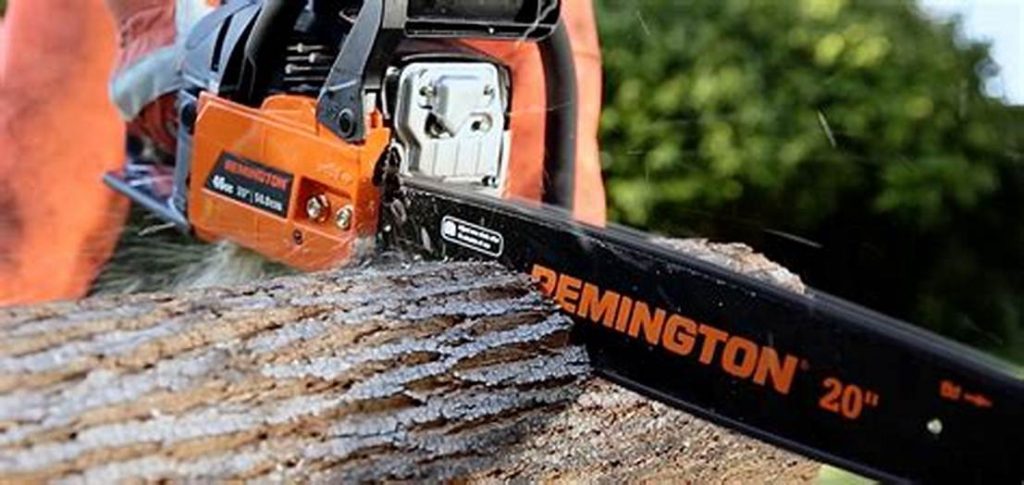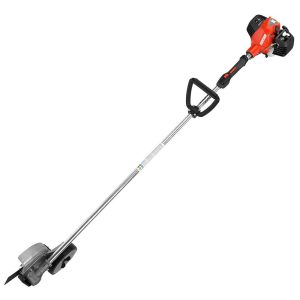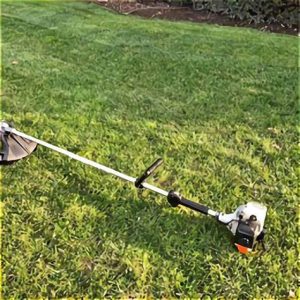Remington Chainsaw Won’t Start for These 13 Reasons
Like most homeowners, you probably don’t get out the chainsaw very often. The most common cause of a chainsaw not starting is leaving the gas in the tank for too long.
Read reading for a list of more possible causes and solutions to your starting issues.
Inadequate air, fuel, or spark will prevent a Remington chainsaw from starting.
The choke may be set too low, the gasoline may be old, the air filter may be clogged, the ignition coil may be defective, the spark plug may be worn out, the fuel filter may be clogged, the carburetor may be unclean, or the spark arrestor may be blocked.
Not starting could be due to a faulty ignition switch or a flooded engine. In order to access the spark plug before making any repairs, the boot must be removed. Make sure you’re taking all the necessary precautions as outlined in the Remington’s user guide.
Some of the links in this post are affiliate links. If you make a purchase after clicking one of these links, we may receive a small commission. We are an Amazon Associates program and get a small percentage of sales that meet certain criteria.

Before diagnosing, fixing, or operating, be sure you’ve read and understood all of the safety precautions included in the equipment’s operator’s manual.
In the event that you lack the necessary expertise, experience, or physical ability to properly complete the repair, it is recommended that you seek the assistance of a professional.
Table of Contents
Start-Up Issues with Remington Chainsaws
Remington Chainsaw Not Starting Due to Faulty Switch or Incorrect Choke
To ensure user safety, Remington chainsaws feature an on/off toggle. Before you try to turn on the saw, make sure the switch is in the “ON” position.
To start a cold engine, you need to draw out the choke knob in addition to having the switch in the correct position. To start the engine, the choke is used to reduce airflow and increase fuel injection.
A cold engine won’t start without this. The engine will not operate without having the choke removed (pushed in) once it has reached operating temperature.
Fix: flip the switch to the on position. A chainsaw that won’t start may also have an issue with the switch or the ground wire.
Incorrect Fuel for a Remington Chainsaw
The chainsaw may have trouble starting if the gas is old. As soon as 30 days after purchase, gas may lose its effectiveness and begin to break down.
Today’s gasoline typically contains ethanol, which is known to absorb water vapor from the atmosphere. Over time, the combination of water and ethanol can dry into a sticky varnish that can clog and corrode the fuel system.
In order to reduce the negative impacts of old gas, which might create fuel restrictions and subsequent starting issues, try the following:
- Use fuel with no more than 10% ethanol.
- Use gasoline or diesel within 30 days of purchase to prevent degradation.
- New fuel can be preserved for longer with the help of a fuel stabilizer.
If you are having trouble starting your vehicle and discover that the fuel is old, the solution is to drain the tank and refill it with new gas.
To help remove moisture and clean the gasoline system, you can use an additive like Sea Foam Motor Treatment or STA-BIL.
When you finally manage to get the chainsaw going, let the fuel go through the machine and into the fuel system.
Misusing a 2-Cycle Remington Chainsaw with Gasoline
Adding the incorrect fuel to your Remington chainsaw could cause it to malfunction. If you get this wrong, you could end up destroying your engine.
A gas-to-oil ratio of 40:1 is recommended for use in a 2-cycle Remington chainsaw.
- A minimum of 89 octane and no more than 10% ethanol must be present in the unleaded gas used in the 40 parts that make up this formula.
- 1-ounce bottle of high-quality 2-cycle oil for air-cooled motors. Do not use conventional motor oil.
You should never use regular gas in a Remington chainsaw. Due to the absence of lubrication, it runs extremely dry and might cause the engine to seize. It’s possible that if you make this kind of mistake, you’ll have to buy a new chainsaw.
Blended fuels without ethanol
Using a fuel without ethanol is preferable, but more expensive, because of the detrimental effects ethanol has on your chainsaw’s performance.
Even though it’s more expensive, having pre-mixed fuel on hand eliminates the need to visit the gas station. This fuel comes in canisters and may be found at any hardware shop.
If you discover that you have put in the incorrect gas-to-oil ratio, the solution is to drain the fuel tank and refill it. Make an effort to fire up the chainsaw.
If your engine won’t start or is running poorly because you suspect you’re using the wrong gasoline, have a small engine mechanic inspect it to rule out the possibility of irreparable damage.
Remington Chainsaw with Clogged Air Filter
When using a chainsaw, dust and debris are thrown into the air. An air filter is placed to filter out the dust before it may enter the engine and cause premature wear.
Sawdust and dirt can clog up the air filter and prevent enough air from reaching the carburetor throat if the filter isn’t cleaned or replaced periodically.
Without enough air, a Remington chainsaw might be difficult to start and maintain.
It’s recommended that the typical homeowner clean or change their air filter multiple times during the season, and then replace it the following year. More frequent maintenance, cleaning, and even replacement will be required if you use your chainsaw more frequently than this.
If you want to keep your engine from overheating and breaking down, you should check the air filter. While it may seem like a hassle, checking the filter’s condition only takes a minute or so.
If the air filter appears to be dirty, take it out and clean it. The filter should be changed if it becomes too dirty or is damaged. You should never operate a chainsaw without first installing an air filter.
Here are the measures you need to take to clean the air filter on your Remington felt chainsaw:
- Take off the cover of the air filter.
- Take out the air filter with caution. Ensure that no dust or debris enters the air intake.
- Use a dry, clean cloth to wipe out the filter housing and the air filter cover, removing any leftover dirt.
- Clean the air filter with water and a mild cleaning agent.
- You should wash it till the water comes out clear.
- Dry the filter thoroughly before using it again.
- Replace the filter and check that it completely blocks the entrance to the air intake.
- Replace the air filter cover.
Remington Chainsaw with a Faulty Spark Plug
A spark plug is what gets a Remington chainsaw going and keeps it going. As spark plugs are consumables, even the most casual of users should replace them once a year.
When a spark plug is dirty or damaged, it can’t do its job properly, which can lead to a variety of performance concerns.
Check the spark plug’s condition, and if it’s fine other than a bit of dirt, cleanse it with a wire brush. If a spark plug is very black in color, the electrode is scorched, or the porcelain is shattered, it needs to be replaced.
Before starting the engine, check that the spark plug is properly wired and that the gap is set according to the manufacturer’s recommendations. Problems getting started can also be caused by these factors.
Remington Chainsaw with a Bad Ignition Coil
It’s the ignition coil you should check if the spark plug is fine but the engine still won’t start. A short can occur if the ignition coil’s winding comes loose.
There won’t be enough power going to the spark plug to make it spark. You can expect difficulties with your chainsaw as a result of this.
A BROKEN CONNECTION IS THE SYMPTOM OF A BAD IGNITION COIL. If you detect a crack in the ignition coil for your Remington, you should replace it immediately.
Remington Chainsaw With A Clogged Fuel Filter
Dirt and debris can be prevented from entering the fuel system by using the fuel filter. The filter, which is a cylindrical component, is housed within the gasoline tank. The fuel filter is connected to the fuel line.
Filters can become clogged through lack of maintenance or by permitting unclean fuel to be used, both of which reduce fuel flow. The saw may not start or run slowly as a result of this.
One ANSWER is to change out a clogged fuel filter.
To change the fuel filter on a Remington chainsaw:
- Before removing the gasoline cap, give the area surrounding it a quick wipe to prevent any dust or debris from entering the tank.
- Taking off the gasoline cap.
- Remember the gasoline filter’s original location in the tank when installing a replacement.
- Hook the gasoline line with a clean bent wire and remove the fuel filter from the tank.
- To remove the fuel filter from the fuel line, you must first secure the fuel line and pull the filter out. Hold tight to the gas line.
- Insert the male end of the new Remington fuel filter into the fuel line and tighten it down until it is secure.
- After installing the filter, you can replace the gasoline tank’s cap.
Remington Chainsaw Primer Bulb Failure
If the primer bulb is broken and won’t take fuel, the engine won’t be able to run properly since the carburetor won’t be supplied with gas.
Just switching out the priming bulb for a new one will fix the problem.
Remington Chainsaw Fuel Line Plugged or Punctured
If the gasoline line becomes clogged, it can cause a fuel restriction. In some cases, this may prohibit the chainsaw from starting.
Removing the clogged fuel line and spraying carburetor cleaning on it is the recommended solution. Remove it by blasting the line with compressed air.
If the blockage cannot be removed or if the fuel line is dry, damaged, or pierced, a new fuel line must be installed.
Remington Chainsaw with the Filthy Carburetor
The carburetor controls how much fuel is added to the air intake before being combusted in the cylinder. If the gasoline passages in the carburetor become clogged from old fuel, the device may no longer operate as intended. Your chainsaw might not start if you do this.
Clean your carburetor yourself if you’re at all mechanically inclined. Take apart the carburetor and use carburetor cleaning to get it clean.
A carburetor that fails to function after being cleaned may require rebuilding or replacement.
Remington Chainsaw with Faulty Recoil Starter
The recoil of a chainsaw is what kicks the motor into gear. Recoil systems can stop functioning if there is a faulty pulley, a missing or loose spring, or damaged clips.
It may be possible to restring the recoil or replace the spring. If the clips or pulley in your recoil are broken, or if anything else in the recoil is malfunctioning, it is best to just replace the entire recoil assembly.
Remington Chainsaw with Blocked Spark Arrestor
Soot can build up on the spark arrestor, a little screen inside the muffler. If the chainsaw’s spark arrestor is clogged, it won’t get enough air to ignite.
A wire brush and some spark arrestor removal could be the answer. If the mesh spark arrestor screen is damaged or cannot be cleaned properly, it should be replaced.
In no circumstances should a chainsaw be operated without this screen or with a damaged screen. Saw dust can cause burns or even a fire if it escapes the saw without a screen.
Remington Chainsaw with a Submerged Motor
If the choke is closed and the engine is started repeatedly by pulling the starter rope, the engine may flood.
That can also occur if the priming bulb is pushed too many times or the starter rope is pulled repeatedly when the switch is off.
SOLUTION:
Remington Chainsaw Troubleshooting: The Engine Has Flooded
- Turn the power on by flipping the switch.
- Make sure the choke is wide open, or in the run position. Choke knob must be pulled in toward machine.
- To repeatedly fire the engine, you must squeeze the trigger while pressing the throttle lockout. There may be a delay of up to fifteen pulls before this begins. That sputtering sound you hear is probably just your chainsaw dying. Just give it another two or three pulls and it ought to fire up.
Guide to Remington Chainsaw Starting Issues and Fixes (Quick Reference Chart)
| Issues | Options |
|---|---|
| Bad Switch or Wrong Choke Setting | Start a cold engine with the choke engaged to reduce airflow. Once the engine has warmed up, you can take the choke off and keep the engine running. Remove and replace the faulty ground wire or switch. |
| Old Fuel | If your fuel has been sitting for more than 30 days, you should replace it. One fuel stabilizer is in order. |
| Incorrect Fuel | Fuel should be drained. Current Remington chainsaws require a 40:1 gas-to-oil ratio for optimal performance. |
| Plugged Air Filter | It’s time to get rid of that clogged air filter and clean it. If the filter appears to be excessively dirty, damp, or damaged, you should get a new one. |
| Bad Spark Plug | Changing out a faulty spark plug. Be sure the spark plug wire is firmly attached and the electrode spacing is appropriate. |
| Faulty Ignition Coil | A malfunctioning ignition coil should be changed out. |
| Plugged Fuel Filter | When putting in a new gasoline filter, make sure the old one is taken out of the tank. |
| Weak Primer Bulb | Substitute a new priming bulb if the old one is broken. |
| Clogged, Dry or Cracked Fuel Line | In order to restore normal fuel flow, a clogged fuel line must be cleared. If a clog cannot be removed or if a gasoline line is dry or fractured, it must be replaced. |
| Filthy Carburetor | The carburetor must be disassembled and cleaned. Repair any broken pieces or swap in a whole new carburetor set. |
| Bad Recoil Starter | If the spring is broken or missing, replace it. If the recoil starting string breaks, replace it. In the event that your recoil starter has been damaged, you should get a new one. |
| Plugged Spark Arrestor | Take off the muffler’s spark arrestor. Remove it, dust it off, then put it back in place. Repair a spark arrestor that has been damaged. |
| Flooded Chainsaw | This can be fixed by following the steps given above. |
Is There Still Anything Wrong with Your Troy-Bilt Chainsaw?
For a comprehensive list of frequent issues and their solutions with Troy-Bilt chainsaws, check out my guide Common Troy-Bilt Chainsaw Issues.
You should definitely bookmark this page as a reference. Whether your chainsaw won’t start, is stuck, or stops working altogether, this guide has you covered. Other issues, such as a chain that won’t turn or an engine that would only run with the choke engaged, are also covered.
Further resources for learning about each topic are provided via the provided links.







